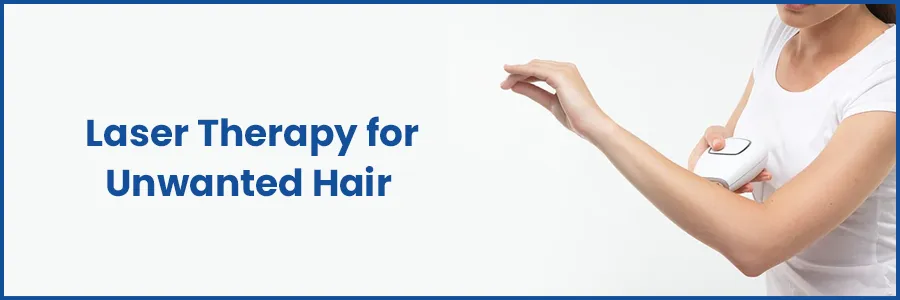Laser Therapy for Unwanted Hair

Unwanted hair can be a bothersome and time-consuming issue for many individuals. Shaving, waxing, and plucking are temporary solutions, and their repetitive nature can become tedious. Fortunately, advancements in cosmetic technology have led to the emergence of laser therapy as a potential long-term solution for unwanted hair removal. This blog will explore how laser therapy works, its effectiveness, safety considerations, and factors that influence its success
Understanding Laser Hair Removal
A non-invasive cosmetic treatment called laser hair removal utilises concentrated light energy to target and destroy hair follicles. The laser emits a specific wavelength absorbed by the pigment (melanin) in the hair follicles. This absorption converts the light into heat, which damages the follicle, inhibiting future hair growth.
Effectiveness of Laser Hair Removal
Laser hair removal has proven highly effective in reducing unwanted hair growth. However, its success can vary depending on several factors, including skin colour, hair colour, hair thickness, and the individual's hormonal profile. The treatment works best on individuals with fair skin and dark, coarse hair, as the contrast between the hair colour and skin tone allows the laser to more precisely target the hair follicles.
Number of Sessions and Maintenance
Laser hair removal requires repeated treatments. Not all hair follicles are active at once as hair grows in cycles.Typically spaced several weeks apart, multiple sessions are required to target hair in various growth stages. Most individuals require six to eight treatments for significant hair reduction. Periodic maintenance sessions may be necessary to address any new hair growth that could occur over time.
Safety Considerations
Most people think laser hair removal is more effective than safe when done by a qualified and experienced specialist. Before the treatment, you must, however, have a full consultation to see whether you are a good candidate and to go through any potential dangers or side effect
Potential Risks and Side Effects
While laser hair removal is generally safe, some potential risks and side effects may include:
- Skin Irritation: Temporary redness, swelling, or mild discomfort in the treated area are common and usually subside within a few hours or days.
- Skin Pigmentation Changes: Laser hair removal can cause Laser hair removal might temporarily lighten or darken the treated skin. This risk is higher for individuals with darker skin tones.
- Scarring: In rare cases, laser therapy may cause scarring, especially if performed by an inexperienced technician or on tanned skin.
- Hair Regrowth: While laser hair removal reduces hair growth significantly, it may not eliminate all hair follicles, and some fine hairs may regrow over time.
- Factors Influencing Results The effectiveness of laser hair removal can vary due to several factors, including:
- Skin Type and Hair Color: As mentioned earlier, individuals with fair and dark hair typically see better results than those with light-coloured or darker skin tones.
- Hair Growth Cycle: Since laser therapy targets active hair follicles, treatments must be timed to coincide with different hair growth cycles.
- Hormonal Factors: Hormonal imbalances, such as those caused by certain medical conditions or medications, can influence hair growth patterns and affect treatment results.
Conclusion
Laser therapy for unwanted hair removal is an effective and long-term solution for many individuals seeking relief from constant shaving, waxing, or plucking. Laser hair removal can significantly reduce hair growth in targeted areas when performed correctly and under the appropriate conditions. However, individual results may vary based on skin type, hair colour, and hormonal influences. To achieve the best outcomes and ensure safety, it is essential to undergo laser therapy under the guidance of a qualified and experienced professional. Always consult a licensed practitioner to discuss your specific needs and determine if laser hair removal is the right option for you
